It's that time of year again!! I know I haven't been blogging lately but this is one of my favorite things win or lose. Here is 2008 and 2010 in case you want to hit the wayback machine. So let's get to it!
There are a number of interesting ones out there tonight. Because we're on the West Coast some of them might be over. But we'll follow anyways. As usual you can find the total transportation election contests at CFTE.
~~~
Cincinnati Charter Amendment: - WIN
No Rail Planning for 10 Years Issue 48 A No Vote Means Streetcar a Go
99% Votes In:
No 51.47%
Yes 48.53%
~~~
Durham County North Carolina Sales Tax for Transit - WIN
97% Votes In:
60% For
40% Against
~~~
Lorain County Ohio General Sales Tax. - LOSS
Bus service will be cut in half if No vote on Issue 22
100% Votes in:
67% No
33% Yes
~~~
Trumbull County Ohio Transit Sales Tax - LOSS
Transit system will cease to exist as of January 1st with No vote
100% Votes in:
35% Yes
65% No
~~
Clark County Washington - WIN
.2% Sales Tax for Transit - Proposition 1
100% Votes in:
54% Approved
46% Rejected
~~~
Seattle Vehicle License Fee - LOSS
100% Votes in:
60% Against
40% For
~~~
Washington Tolling Initiative 1125
No Vote Would be Win
Washington State Results
9:50pm PT 49% Yes 51% No
9:55pm PT 49.07% Yes 50.93% No
5:39pm PT 11.9.2011 - 48.56% No 51.44%
Tuesday, November 8, 2011
Wednesday, October 19, 2011
Go Underground Young Man!
Each time I go to a Rail~Volution conference I feel a bit revitalized. For some reason just seeing people doing all the great work that they do really gets me excited about the future, even though it's always hard when recent politics dictates one step forward and two steps back. I personally want to take 5 steps forward but we know that isn't how it works.
Some of the best parts of the conference come from the stats and stories that people tell in the sessions and in the hallways. Today I learned what "Festival Parking" in development projects was from Art Lomenick and yesterday learned about a CDC program that invests in communities looking to improve health outcomes.
But one of my favorite comments came from one of my favorite public officials. Harriet Tregoning mentioned in her session (and it was repeated in Streetsblog and STB posts) that subway tracking heavy rail is the best way to go when it comes to surface development. While there are a few examples of it working around the country, I think the clean slate it affords developers and pedestrians is a huge bonus over the long term.
This also brings up another thing I would like to see in regions around the country. Usually we get into the chicken and egg question whether the transit or density needs to come first but ultimately I think transportation investment drives development investment and putting these lines underground allows us to think about these as a long term investment, even though people these days don't think that way.
What I would like to see is a program for building at least three line subway lines in each major city in the United States. Now I'm not talking about these hybrid systems we get in the United States like BART but true central city Metros with transfer centers at the end that might stretch 3 miles from the center. What this would do is push cities to make urban development legal. The demand for development along major corridors stretches from the market generated around the gravity of central employment district. The benefit is that if you can get further from the center in ten minutes by putting the line underground, you will be able to build higher and create more walkable, sustainable development than you would have with just the bus. We see what a ten minute trip from downtown on a streetcar can do, we just need to get multiple modes going and augment with the subway.
I know its dreaming because it can't really happen given the current environment, but its really what I believe should happen. This model is there with the DC Metro, we just need to make it happen somehow.
Some of the best parts of the conference come from the stats and stories that people tell in the sessions and in the hallways. Today I learned what "Festival Parking" in development projects was from Art Lomenick and yesterday learned about a CDC program that invests in communities looking to improve health outcomes.
But one of my favorite comments came from one of my favorite public officials. Harriet Tregoning mentioned in her session (and it was repeated in Streetsblog and STB posts) that subway tracking heavy rail is the best way to go when it comes to surface development. While there are a few examples of it working around the country, I think the clean slate it affords developers and pedestrians is a huge bonus over the long term.
“In the short term, under-grounding can be very expensive, but in the long term it saves a lot of money,” Zimmerman said. The development that occurs above the station easily pays for the tunnel, and there’s significant savings on maintenance when rails are protected from the elements. But perhaps more important, there’s little difference between a transit line and an Interstate when it comes to fracturing the fabric of the urban environment. “A railroad takes up a lot of space and creates a barrier — something you can’t get across, like a highway,” he said.
This also brings up another thing I would like to see in regions around the country. Usually we get into the chicken and egg question whether the transit or density needs to come first but ultimately I think transportation investment drives development investment and putting these lines underground allows us to think about these as a long term investment, even though people these days don't think that way.
What I would like to see is a program for building at least three line subway lines in each major city in the United States. Now I'm not talking about these hybrid systems we get in the United States like BART but true central city Metros with transfer centers at the end that might stretch 3 miles from the center. What this would do is push cities to make urban development legal. The demand for development along major corridors stretches from the market generated around the gravity of central employment district. The benefit is that if you can get further from the center in ten minutes by putting the line underground, you will be able to build higher and create more walkable, sustainable development than you would have with just the bus. We see what a ten minute trip from downtown on a streetcar can do, we just need to get multiple modes going and augment with the subway.
I know its dreaming because it can't really happen given the current environment, but its really what I believe should happen. This model is there with the DC Metro, we just need to make it happen somehow.
Sunday, September 25, 2011
Norway in a Nutshell
That's the title of the great suggested tour that leads from Oslo to Bergen. I discussed Copenhagen and Stockholm in my earlier post, and now its time to cover Norway. Such an amazingly beautiful place and unfortunately the camera really can't do it any justice. But it'll have to do for now.
Our adventure starts with water and lots of it. It's definitely not something they'll have to worry about anytime soon. At least it seems that way. If you like waterfalls, you'll love Norway.
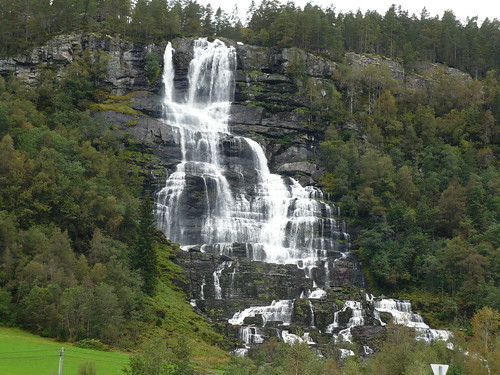
Also, the train ride between Oslo and Bergen is beautiful, but if you must get off the train, I recommend highway 13. It's got more tunnels than I knew existed in the world and some beautiful bus shelters.
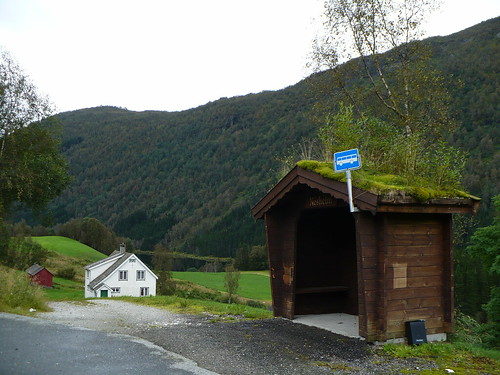
The water is pretty still as well.

And the ski resorts have grass roofs
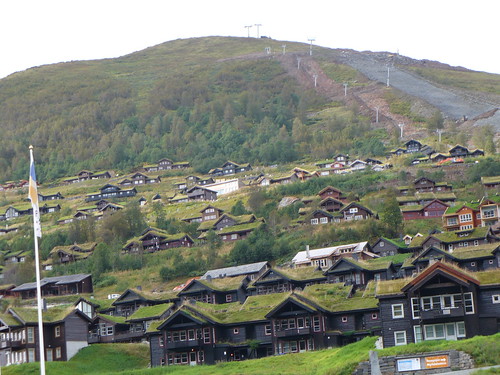
At the end of highway 13 is the town of Vik.
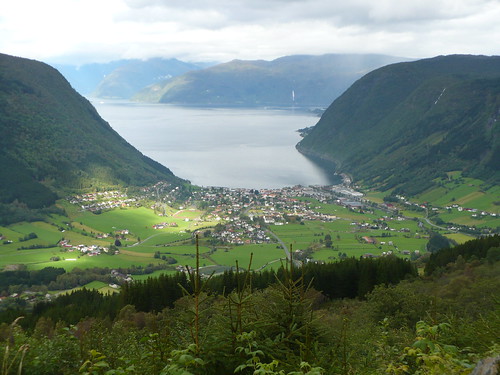
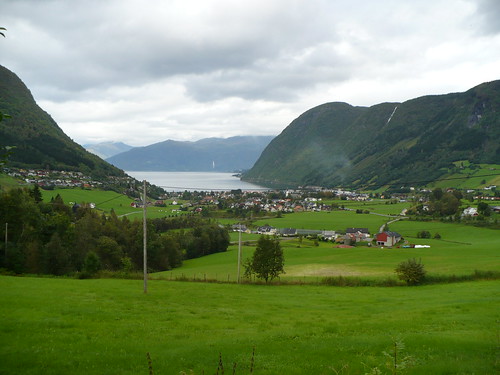
And in Vik is Hopperstad Stave Church, built in the 1100s, this church has been renovated to a certain extent but the inside is still in tact and an amazing specimen. It is said to be the oldest surviving church of its kind.
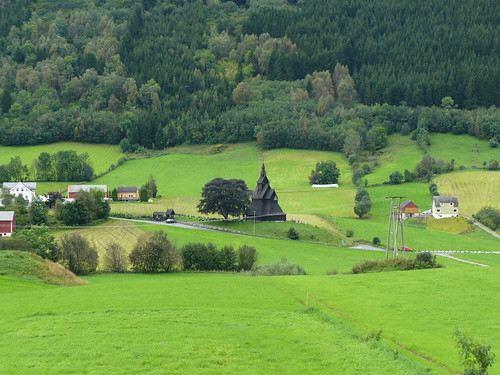
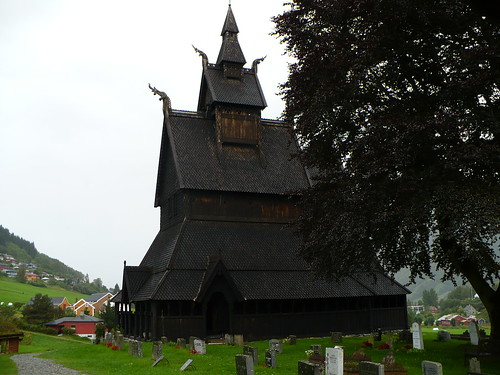
On the train from Oslo to Bergen, the train ride is full of farmhouses and deep canyons. And we rode in the car that allows pets.

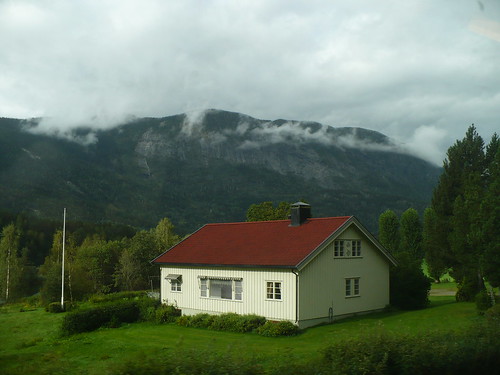
At the Finse Glacier is the highest train station in Northern Europe. Only at about 4,000 feet the tree line doesn't go as high as it does in California or the Rockies because it gets so much colder. We found out later as well that this was where they filmed the Hoth scenes for Empire Strikes Back.
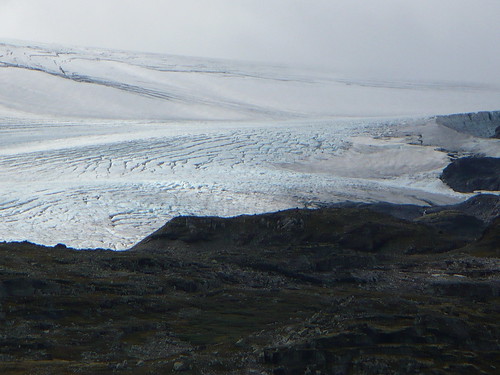
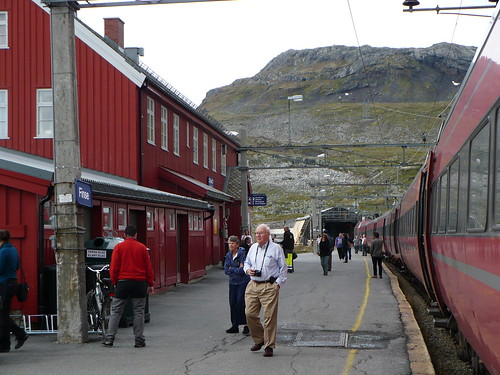
On the other side of the Train ride is the beautiful Fjords with more waterfalls. This one was from a train that has some serious elevation changes.
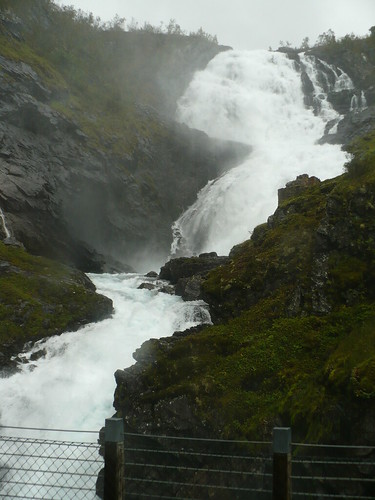
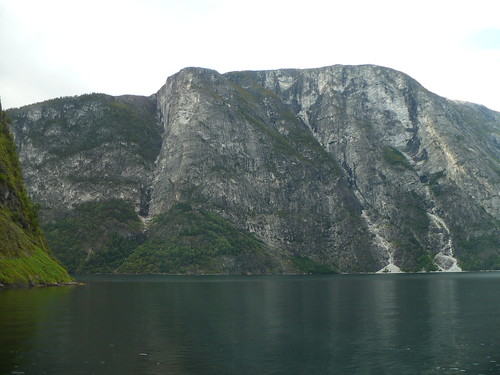
On the way back, we were in a commuter type bus going down this switchback, which was quite amazing that the driver could pull it off
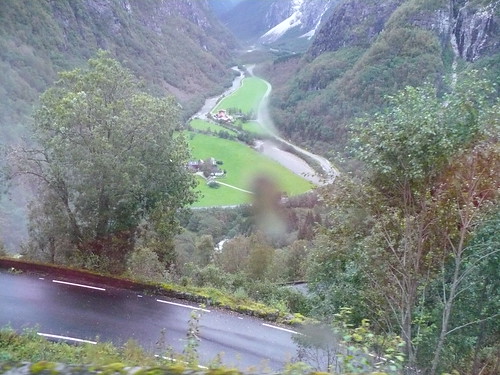
And Bergen is a beautiful city
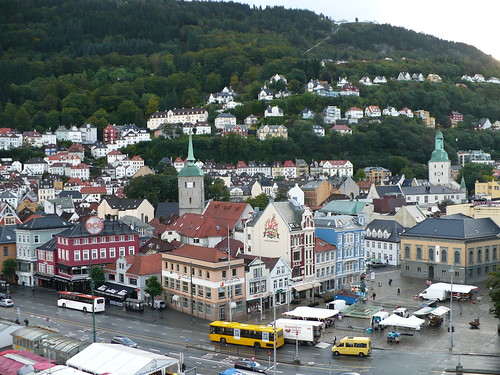
The Hanseatic quarter burnt down in the 1700s and the debris was pushed into the bay and built upon. But that was a bad idea as the buildings are shifting so much that some of them don't match up.

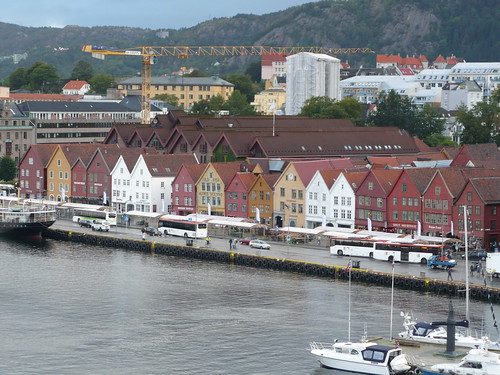
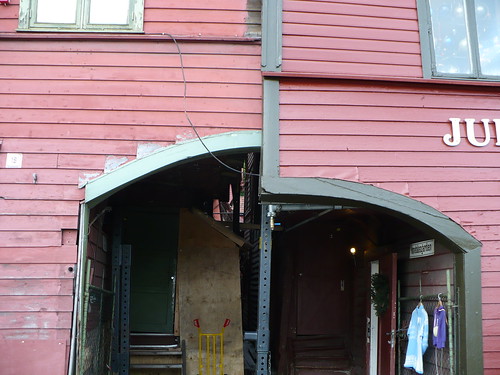
Back in Oslo, Frogner Park is a must see and here's the obligatory tram shot. The photo below is a really cool water feature that the trams run directly over.
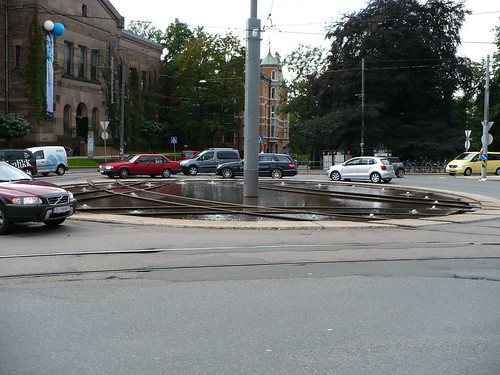


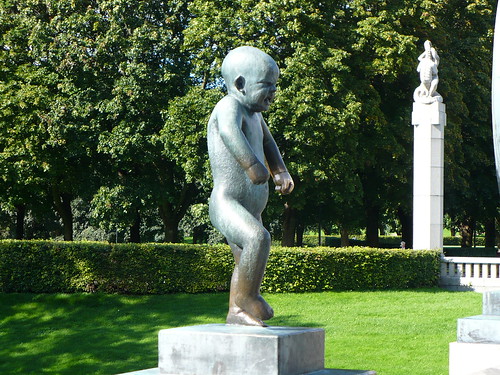
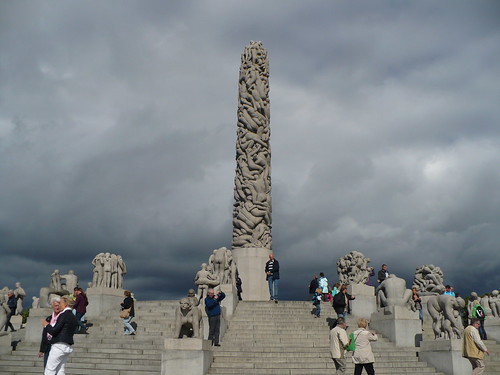
And the urbanism is pretty great as well
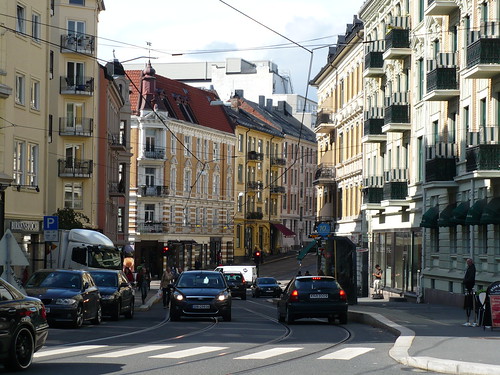
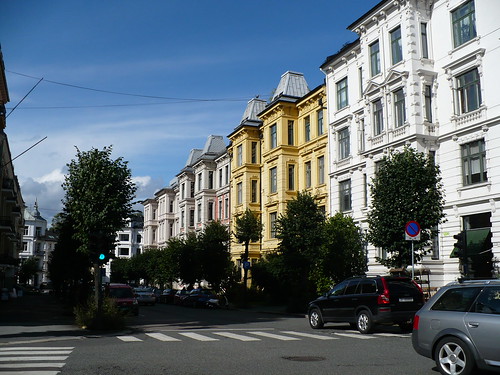
Finally though, I thought I would share our prison abroad, the US Embassy in Norway. That's what I thought it was at least the first time I saw it. It's too bad we create so many enemies and have folks that don't like us that we need to even do this. At least there is a tram line.
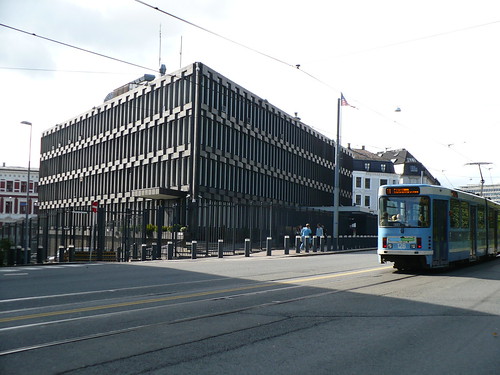
Our adventure starts with water and lots of it. It's definitely not something they'll have to worry about anytime soon. At least it seems that way. If you like waterfalls, you'll love Norway.

Also, the train ride between Oslo and Bergen is beautiful, but if you must get off the train, I recommend highway 13. It's got more tunnels than I knew existed in the world and some beautiful bus shelters.

The water is pretty still as well.

And the ski resorts have grass roofs

At the end of highway 13 is the town of Vik.


And in Vik is Hopperstad Stave Church, built in the 1100s, this church has been renovated to a certain extent but the inside is still in tact and an amazing specimen. It is said to be the oldest surviving church of its kind.


On the train from Oslo to Bergen, the train ride is full of farmhouses and deep canyons. And we rode in the car that allows pets.


At the Finse Glacier is the highest train station in Northern Europe. Only at about 4,000 feet the tree line doesn't go as high as it does in California or the Rockies because it gets so much colder. We found out later as well that this was where they filmed the Hoth scenes for Empire Strikes Back.


On the other side of the Train ride is the beautiful Fjords with more waterfalls. This one was from a train that has some serious elevation changes.


On the way back, we were in a commuter type bus going down this switchback, which was quite amazing that the driver could pull it off

And Bergen is a beautiful city

The Hanseatic quarter burnt down in the 1700s and the debris was pushed into the bay and built upon. But that was a bad idea as the buildings are shifting so much that some of them don't match up.



Back in Oslo, Frogner Park is a must see and here's the obligatory tram shot. The photo below is a really cool water feature that the trams run directly over.





And the urbanism is pretty great as well


Finally though, I thought I would share our prison abroad, the US Embassy in Norway. That's what I thought it was at least the first time I saw it. It's too bad we create so many enemies and have folks that don't like us that we need to even do this. At least there is a tram line.

Sunday, September 11, 2011
Seafarers of Scandinavia
Well maybe not, but we got rained on. Every two years I try to go somewhere interesting for a vacation. Over the last few years I've been to Eastern Europe and Italy with my parents and sister and decided to go a bit further north in Europe to Scandinavia this time. I try to share some photos and stories so here is my latest adventure!
First we flew into Stockholm, some of the highlights included the awesome train from the airport that took 20 minutes to downtown at 205 km/hr. That's one fast ride. Over the course of two weeks, we flew, took intercity rail, tram, bus, commuter bus, metro, ferry, large ferry, taxi, and yes rental car. It rained a lot so no bikes. But its not all about transportation. Here are some shots from Sweden and Denmark. I'll get to Norway in another post.
Scandinavia is famous for bikes, but I was impressed also with the subways and trams. I would be remiss if I didn't start with the Trams. This lane is shared by Trams and buses and the vehicle is a Bombardier Flexity.
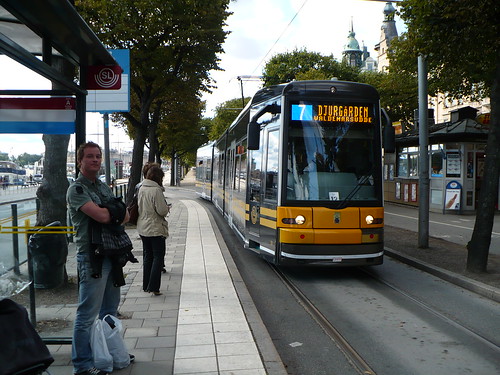
Here's Rush hour in Stockholm:

And one of the worst traffic nightmares in the city (Slussen Locks) protects cyclists with some colorful barriers
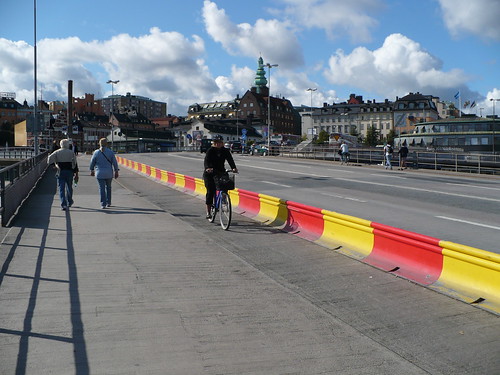
But even more fun in these cities is the old central city. In Stockholm, this area is known as Gamla Stan. The Central Square known as the Stortorget has a fountain that is the center of the country. Distances in different parts of the country are measured to it and it has been the location for some famous historical events. It is said that the white stones on the red building in the photo represent each of the Swedish nobles that were beheaded in the square by the King of Denmark.
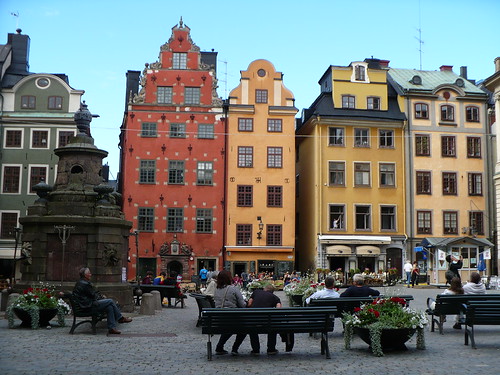
Back in the narrow passageways behind the Stortorget you can see small Phoenix's over windows representing who had paid their fees for the fire department to save the house.
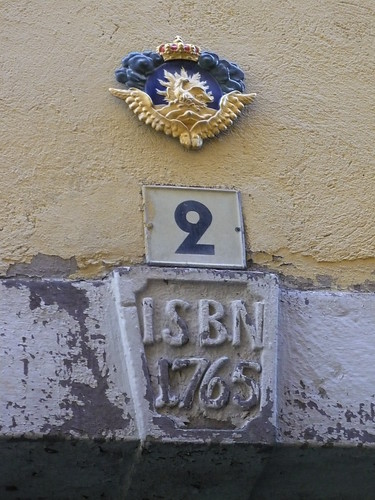
Across the lake from Gamla Stan is the 1700s Warship Vasa that sunk only a few minutes after launch and was only found again at the bottom of the lake in the 1950s. It is probably one of the most amazing things you'll see in the city.


On to Copenhagen, home of the bikes! It's a great city but I thought it felt a little less clean than Oslo, Bergen, or Stockholm.
In the Assistens Kirkegaard, half park/half cemetary, noted Danes including Hans Christian Anderson and Neils Bohr are buried. It's a beautiful place.
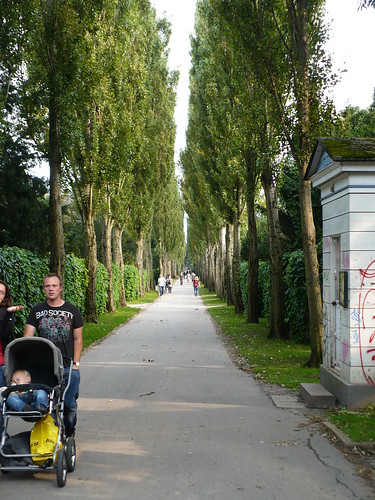
Off the main shopping street, a small back ally called the Pistolstrade will bring you to some Half Timbered buildings that are fun and brightly colored.

Back into the City, the City Hall is defended by a pair of fearsome looking Walruses (Walri?)

Across town at the Rosenborg Slot (Castle), the crown has been showing off the Jewels and living quarters of Danish Kings since the end of the 19th Century. These are some of the toy soldiers kept in the basement vault.
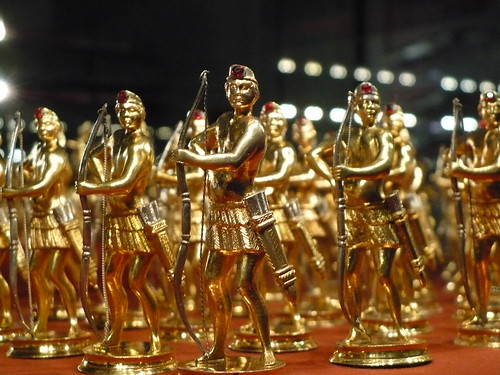
Christian IV was the major part of the progress of the Danes and there are a number of monuments to his movement to Lutheranism around the city including this history statue. The guy was pretty hardcore. At his castle Rosenborg, there is a room with his shirt bloodied after a battle and the shrapnel pulled from his eye that he made into ear rigns and gave to his mistress. That's love right there. Or something...

The first day we also took a train to Roskilde, home to a major music festival and the Viking Ship museum. I highly recommend it if you have kids, or even if you don't. The cool thing is that they show how the ships are built and how they used the wood to build them. This photo shows what parts of the tree they used for certain parts of the boat. Also, they've uncovered a number of viking ships including merchant vessels and warboats. Very cool.


I've got a lot from Norway as well. I'll post those later this week. Until then you can see them all on my Flickr page.
First we flew into Stockholm, some of the highlights included the awesome train from the airport that took 20 minutes to downtown at 205 km/hr. That's one fast ride. Over the course of two weeks, we flew, took intercity rail, tram, bus, commuter bus, metro, ferry, large ferry, taxi, and yes rental car. It rained a lot so no bikes. But its not all about transportation. Here are some shots from Sweden and Denmark. I'll get to Norway in another post.
Scandinavia is famous for bikes, but I was impressed also with the subways and trams. I would be remiss if I didn't start with the Trams. This lane is shared by Trams and buses and the vehicle is a Bombardier Flexity.

Here's Rush hour in Stockholm:

And one of the worst traffic nightmares in the city (Slussen Locks) protects cyclists with some colorful barriers

But even more fun in these cities is the old central city. In Stockholm, this area is known as Gamla Stan. The Central Square known as the Stortorget has a fountain that is the center of the country. Distances in different parts of the country are measured to it and it has been the location for some famous historical events. It is said that the white stones on the red building in the photo represent each of the Swedish nobles that were beheaded in the square by the King of Denmark.

Back in the narrow passageways behind the Stortorget you can see small Phoenix's over windows representing who had paid their fees for the fire department to save the house.

Across the lake from Gamla Stan is the 1700s Warship Vasa that sunk only a few minutes after launch and was only found again at the bottom of the lake in the 1950s. It is probably one of the most amazing things you'll see in the city.


On to Copenhagen, home of the bikes! It's a great city but I thought it felt a little less clean than Oslo, Bergen, or Stockholm.
In the Assistens Kirkegaard, half park/half cemetary, noted Danes including Hans Christian Anderson and Neils Bohr are buried. It's a beautiful place.

Off the main shopping street, a small back ally called the Pistolstrade will bring you to some Half Timbered buildings that are fun and brightly colored.

Back into the City, the City Hall is defended by a pair of fearsome looking Walruses (Walri?)

Across town at the Rosenborg Slot (Castle), the crown has been showing off the Jewels and living quarters of Danish Kings since the end of the 19th Century. These are some of the toy soldiers kept in the basement vault.

Christian IV was the major part of the progress of the Danes and there are a number of monuments to his movement to Lutheranism around the city including this history statue. The guy was pretty hardcore. At his castle Rosenborg, there is a room with his shirt bloodied after a battle and the shrapnel pulled from his eye that he made into ear rigns and gave to his mistress. That's love right there. Or something...

The first day we also took a train to Roskilde, home to a major music festival and the Viking Ship museum. I highly recommend it if you have kids, or even if you don't. The cool thing is that they show how the ships are built and how they used the wood to build them. This photo shows what parts of the tree they used for certain parts of the boat. Also, they've uncovered a number of viking ships including merchant vessels and warboats. Very cool.


I've got a lot from Norway as well. I'll post those later this week. Until then you can see them all on my Flickr page.
Friday, August 12, 2011
The Seats are Gross
BART is getting a bit old. It's not New York Subway old or heck Budapest Subway old, but the train cars in the BART system are the oldest out of any in the country. So forgive me if I get annoyed when Linton Johnson, the PR person for BART says that replacing cars is sexy while routers and other background operational stuff is not.
You know what else you can't run trains without? Paying customers! Those BART seats in many of the cars are so gross looking and sagging that I refuse to sit down on many of them. If anyone wants a tip, generally the last car on the Pittsburgh Bay Point train is refurbished with rubber floors and new seats. Amazing what that can do to make me feel better about sitting down where a million people have been.

Also, if new rail cars are so sexy, how come we didn't want sexy time faster than 40 years of the system? And as Ben at Second Avenue Sagas says, make em plastic. I'm not saying don't fix the bugs in the system. Being on time also keeps customers. But don't pit one improvement over another. You need both. Get it done already.
"Things like routers and train control systems aren't as sexy as new rail cars," Johnson said, "but you can't run trains without those systems."
You know what else you can't run trains without? Paying customers! Those BART seats in many of the cars are so gross looking and sagging that I refuse to sit down on many of them. If anyone wants a tip, generally the last car on the Pittsburgh Bay Point train is refurbished with rubber floors and new seats. Amazing what that can do to make me feel better about sitting down where a million people have been.

Also, if new rail cars are so sexy, how come we didn't want sexy time faster than 40 years of the system? And as Ben at Second Avenue Sagas says, make em plastic. I'm not saying don't fix the bugs in the system. Being on time also keeps customers. But don't pit one improvement over another. You need both. Get it done already.
Thursday, August 11, 2011
Anti-Sprawl Transit Chief?
Former Charlotte transit chief Keith Parker has pushed San Antonio towards Streetcar and BRT faster than anywhere else I've seen in the last few years. He had just moved in to that position back in 2009. According to the Express News, he hopes to have lines under construction by January of 2012.
The best part isn't the streetcar push though, it's that they are taking funding to spend on urban projects that would have been spent in unincorporated parts of the county.
For those of you not familiar with Texas land use issues, unincorporated areas generally have no zoning restrictions and very little subdivision restrictions. Regions like Houston have areas outside the city limits that form Municipal Utility Districts (MUDs) to provide water and sewer infrastructure but ultimately they end up sucking a lot of transportation funding away from cities given their peripheral nature. To be fair, I grew up in a place that was once a MUD and then annexed by Houston. It was well planned for a burb but most of them are not master planned communities that end up with 65,000 people.
In planning school one year we had class t-shirts that said "In the ETJ, no one can hear you scream". The extra territorial jurisdiction is a part of the county which the city can't zone but can annex, meaning you're going to get the worst sprawl you've ever seen from those parts of the region. So with this quote I was quite happy to hear that the county wasn't going to get sprawl generating funds and that it quite possibly could be used for a streetcar.
The best part isn't the streetcar push though, it's that they are taking funding to spend on urban projects that would have been spent in unincorporated parts of the county.
“Removing $55 million from the county,” he [opponent] said, “diminishes our ability to provide infrastructure services in unincorporated areas of the county.”
For those of you not familiar with Texas land use issues, unincorporated areas generally have no zoning restrictions and very little subdivision restrictions. Regions like Houston have areas outside the city limits that form Municipal Utility Districts (MUDs) to provide water and sewer infrastructure but ultimately they end up sucking a lot of transportation funding away from cities given their peripheral nature. To be fair, I grew up in a place that was once a MUD and then annexed by Houston. It was well planned for a burb but most of them are not master planned communities that end up with 65,000 people.
In planning school one year we had class t-shirts that said "In the ETJ, no one can hear you scream". The extra territorial jurisdiction is a part of the county which the city can't zone but can annex, meaning you're going to get the worst sprawl you've ever seen from those parts of the region. So with this quote I was quite happy to hear that the county wasn't going to get sprawl generating funds and that it quite possibly could be used for a streetcar.
Sunday, August 7, 2011
OT: 120 Minutes on MTV
Before I was a transit geek I was a runner. After my freshman year in high school, I became a real runner and actually trained for it, logging around 45 miles a week then and working my way up to a few 90-100 mile weeks in college. During that time in the summer when you were on your own to train, I would run late at night. During the day I was a lifeguard at the local pool but at night it was my job to run. But at times it could get lonely on the streets under the lights at about 10-11pm at night and a few times I was followed home by police officers who thought I would break midnight curfew.

Because it was such a solemn undertaking, I often brought along my walkman sports. Because running was bouncy, I made mix tapes using my stereo from CDs at home and had a few favorites at the time. It varied based on my tastes but this was officially the time when I started to make music a part of my life. Many of the songs that I have in my itunes now were from that era, and I can often remember the part of the run when Depeche Mode came on or Gravity Kills.
But when I would get home from my run at midnight or so it would be about 80 degrees out still and I needed some time to cool down. So after I had hosed off (yes I said hosed, one of the reasons why I can't stand humidity and live in San Francisco) I would come in the house, get a glass of water, and turn on the TV. More often than not, every day but Saturday was MTV which would play videos late at night or show Beavis and Butthead/Daria. Saturday nights was time for SNL if I could catch it. Those were the glory days with Chris Farley, Adam Sandler and Phil Hartman.
But Sunday nights were 120 minutes, which basically got me introduced to alternative music that I ended up liking much more than what everyone else seemed to be listening to at the time. Top 40 or country was prevalent and while I did like some Top 40, alternative was more my style. So when I heard 120 minutes was coming back I was elated.
When looking up the old 120 minutes show archive, I was amazed at how much the show did actually shape my tastes. Going through the videos played during each of those shows was like going back in time. I don't have all of them on my ipod but I do know that I liked most of them. Just going through 1995 made me smile. Bands like Catherine Wheel, the Toadies, Jeff Buckley, Blur, and the Rentals just to name a few were on the list. If you're a lover of alternative music from the early to late 90s, check out the archive just for the names alone. Instant memory flashback.
I don't have cable these days but I am going to watch the show online and hopefully Matt Pinfield will bring back its former glory and introduce me to the music like I remember, with back stories, associations, and random information. That's something you can't get from Pandora or other music sharing systems and it's one thing I think that has made finding new music much less enjoyable over time.
So even though MTV doesn't play videos and got lame, if you love music, check out the first episode.

Because it was such a solemn undertaking, I often brought along my walkman sports. Because running was bouncy, I made mix tapes using my stereo from CDs at home and had a few favorites at the time. It varied based on my tastes but this was officially the time when I started to make music a part of my life. Many of the songs that I have in my itunes now were from that era, and I can often remember the part of the run when Depeche Mode came on or Gravity Kills.
But when I would get home from my run at midnight or so it would be about 80 degrees out still and I needed some time to cool down. So after I had hosed off (yes I said hosed, one of the reasons why I can't stand humidity and live in San Francisco) I would come in the house, get a glass of water, and turn on the TV. More often than not, every day but Saturday was MTV which would play videos late at night or show Beavis and Butthead/Daria. Saturday nights was time for SNL if I could catch it. Those were the glory days with Chris Farley, Adam Sandler and Phil Hartman.
But Sunday nights were 120 minutes, which basically got me introduced to alternative music that I ended up liking much more than what everyone else seemed to be listening to at the time. Top 40 or country was prevalent and while I did like some Top 40, alternative was more my style. So when I heard 120 minutes was coming back I was elated.
When looking up the old 120 minutes show archive, I was amazed at how much the show did actually shape my tastes. Going through the videos played during each of those shows was like going back in time. I don't have all of them on my ipod but I do know that I liked most of them. Just going through 1995 made me smile. Bands like Catherine Wheel, the Toadies, Jeff Buckley, Blur, and the Rentals just to name a few were on the list. If you're a lover of alternative music from the early to late 90s, check out the archive just for the names alone. Instant memory flashback.
I don't have cable these days but I am going to watch the show online and hopefully Matt Pinfield will bring back its former glory and introduce me to the music like I remember, with back stories, associations, and random information. That's something you can't get from Pandora or other music sharing systems and it's one thing I think that has made finding new music much less enjoyable over time.
So even though MTV doesn't play videos and got lame, if you love music, check out the first episode.
Tuesday, July 19, 2011
Bad Employment Location Decisions
Annoying me to no end are decisions to locate major new employment opportunities in areas that have no access to regional rapid transit. The most recent of these is the idea that Berkeley Labs would take the Golden Gate Fields horse racing track and redevelop it to bring all the employees together that were once in different places.
This is a laudable goal however it's right next to a major freeway and will basically add more transportation costs to the University, AC Transit district while also increasing auto traffic (A mention of 2,500 cars). I'm sure my taxes will have to pay for that stupidity. Apparently downtown Oakland isn't good enough.
I think Auto Row might be a good location for this campus, right next to Pill Hill and Kaiser hospital. There's plenty of space for a few tall buildings, its ripe for redevelopment because of all the parking lots, and its on a major transit route, and fairly close to BART. Another good place would be downtown Oakland. There's plenty of space if they really took a look. People seem to be lazy and look for what amounts to an urban greenfield. They really need to get an imagination.
This is a laudable goal however it's right next to a major freeway and will basically add more transportation costs to the University, AC Transit district while also increasing auto traffic (A mention of 2,500 cars). I'm sure my taxes will have to pay for that stupidity. Apparently downtown Oakland isn't good enough.
I think Auto Row might be a good location for this campus, right next to Pill Hill and Kaiser hospital. There's plenty of space for a few tall buildings, its ripe for redevelopment because of all the parking lots, and its on a major transit route, and fairly close to BART. Another good place would be downtown Oakland. There's plenty of space if they really took a look. People seem to be lazy and look for what amounts to an urban greenfield. They really need to get an imagination.
Monday, July 11, 2011
The Headline Doesn't Match the Story
Ok, can someone tell me if I'm going crazy here? First the misleading PI headline:
Study: Surface-transit would clog regional trafficThen the FIRST paragraph:
The state's plans for a tolled deep-bore tunnel to replace the Alaskan Way Viaduct would bring slightly more traffic congestion to downtown Seattle than a surface-transit concept favored by Mayor Mike McGinn, according to an analysis in the tunnel project's Final Environmental Impact StatementSo the tunnel would bring more traffic to the surface streets right? Then later on:
With no place for all 110,000 vehicles to go, speeds would decrease and fewer drivers would travel through Seattle's city center, resulting in less traffic, according to an analysis in the environmental assessment.The idea is that surface transit would make through traffic harder, and people would be annoyed and say I'm not going to make that trip. That is a great result! But that headline suggests that it would clog traffic all together when that is not the case. I'm guessing some headline writer at the PI thought it would be good, but it totally shows some serious windshield perspective.
Going Car Free in San Francisco
Funny story, I just had a little freak out about whether my car was parked on the right side of the street or not for street sweeping in the morning. If you don't move it, you get a ticket. But the freak out was unfounded because then I realized that I don't have a car anymore.
I sold my beloved Volkswagen Jetta I nicknamed "The Green Goblin" on Saturday. There have been many good times in that car that I've had for 12 years. It's been across the country a few times, was put in a classified ad as a part of a prank war in college that had people calling and asking if my brand new Jetta was for sale for just $2,000 and been splashed by cattle poo flying from a cattle car in Colorado. Its also served as sleeping quarters outside the four corners and been across the great state of Nevada on Highway 50 at speeds I probably shouldn't mention.
I've lived in San Francisco with the Green Goblin for 5 years and it served me well. I was able to take people around the city that came for a visit and go on day trips around the region and city to places I couldn't easily get without it and generally on a whim. There are many benefits to owning a car, generally the mobility they provide is excellent and because i'm a city planner I like to know my surroundings, including random streets and quirky places that you might not know about otherwise.
I sold my beloved Volkswagen Jetta I nicknamed "The Green Goblin" on Saturday. There have been many good times in that car that I've had for 12 years. It's been across the country a few times, was put in a classified ad as a part of a prank war in college that had people calling and asking if my brand new Jetta was for sale for just $2,000 and been splashed by cattle poo flying from a cattle car in Colorado. Its also served as sleeping quarters outside the four corners and been across the great state of Nevada on Highway 50 at speeds I probably shouldn't mention.
I've lived in San Francisco with the Green Goblin for 5 years and it served me well. I was able to take people around the city that came for a visit and go on day trips around the region and city to places I couldn't easily get without it and generally on a whim. There are many benefits to owning a car, generally the mobility they provide is excellent and because i'm a city planner I like to know my surroundings, including random streets and quirky places that you might not know about otherwise.
But moving my car because of street sweeping was a pain and I racked up a lot of tickets. In fact i'm sure that I more than paid for better Muni service that every citizen in San Francisco actually deserves rather than what they get. If everyone paid as much as I did every year we could build a real subway network in this town and everyone could go car free, but I digress. The only time of the week I used the car was going to visit my Gramma in the east bay on Wednesdays. I've been walking and biking there from BART the last few weeks and its been some really good exercise as well as an exercise in patience when dealing with BART's rules about bikes during rush hours.
Ultimately though, the clutch went bad and it was time for me to practice something I talk about at work all the time, living a car free lifestyle. I've never really advocated it before but seeing all those affordability index charts must have gotten to me. To see what its actually like to go car free, and be able to see the actual costs of driving when I use a zipcar will be refreshing but certainly a little scary. But for now, its just my legs, my bike, my Clipper Card and my Zipcard...and perhaps a taxi after a night at Polk Gulch. I really wish someone would survey me for the census now with the long form...
Subscribe to:
Posts (Atom)


